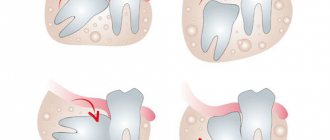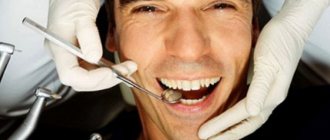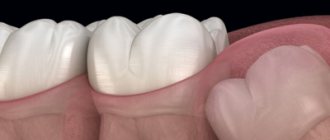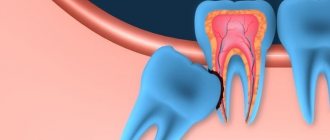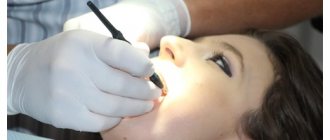Removal of the nerve of a tooth is a procedure that is used in the treatment of acute inflammatory processes in teeth, as well as in the process of prosthetics and dental restoration. The purpose of this operation often causes fear in patients, because from school we know that nerve endings are extremely sensitive. However, modern dentistry makes it possible to solve this problem, allowing it to be performed painlessly, with a minimal recovery period. And in order to no longer be afraid of going to the dentist, let's learn more about depulpation, or the procedure for removing the nerve of a tooth.
What is a dental nerve?
The nerve of a tooth is a bundle of nerve endings that is located in the center of the tooth under the hard tissues of dentin and enamel. In medicine it is called pulp, and the process of removing the nerve is called depulpation.
The pulp performs a number of functions that are important for the growth and maintenance of dental health. It nourishes the hard tissues of the tooth, prevents the penetration of infections into the periodontium, and most importantly, is responsible for the sensitivity of the teeth when chewing. If the pulp is removed, the teeth require constant care, since adequate nutrition of the hard tissues is stopped. Therefore, the dentist, as a rule, decides on depulpation only if there are serious indications.
Stages of treatment
- Diagnostics . Before treatment, the doctor conducts an examination and takes an x-ray. It will show the structure of the root canals, their number, the depth of the carious cavity, and the condition of the tooth. Sometimes treatment is impossible and the tooth needs to be removed.
- Anesthesia . To numb the tooth and provide a comfortable treatment, local injection anesthesia (injection) is performed. In case of severe pain and severe inflammation, the gums are treated with an anesthetic gel or spray before the injection.
- Installation of insulation (cofferdam) . To isolate the canals from saliva and bacteria, a rubber dam is used - this is a latex scarf that is placed on the tooth being treated. Thanks to the rubber dam, sterile conditions are created for placing fillings and treating root canals.
- Treatment of hard dental tissues . All carious and destroyed tissues are removed, and access to the pulp chamber is created. A water-cooled drill is used to prevent surfaces from overheating. All fragile tooth walls are also removed in order to initially create good conditions for future restoration.
- Nerve removal . It is performed with small sterile instruments that look like needles. In some cases, a special apparatus is used: a tip with rotating instruments. This happens painlessly, since anesthesia was previously administered.
- Root canal treatment . The doctor cleans the canals, rinses them with antiseptic solutions, and measures their length. This is necessary in order to eliminate all infectious particles from the canals.
- Temporary filling . It is installed when it is impossible to fill the root canals immediately on the first visit. This also allows you to monitor the patient’s condition (after acute pain).
- Canal filling . Occurs on the first or next visit. A method for filling the canals is selected, then a permanent filling is placed in aesthetic dentistry.
- Control shot . After filling the canals, it is important to make sure that they are sealed tightly, to the top, and that there are no voids left. If the voids remain, re-inflammation will occur.
Removal of the tooth nerve: indications for the procedure
The most common reason that can lead to the need to remove the nerve of a tooth is pulpitis. This is an inflammation of the dental pulp, which occurs as a result of advanced caries. In healthy teeth, the pulp is protected by tooth enamel, but with carious lesions, it is exposed and begins to become inflamed from any influence. As a result, the patient feels acute pain, which can only be eliminated by removing the damaged nerve of the tooth.
Other indications for depulpation include:
- The need to grind tooth enamel when installing a crown;
- Mechanical damage to the tooth - the presence of chipped enamel;
- The presence of deep carious lesions, for the prevention of pulpitis in the future.
In the situations listed above, the dentist may decide to remove the pulp, especially if the tooth is causing pain and discomfort to the patient.
How is the tooth nerve removal procedure performed?
For most people, the fear of removing the nerve of a tooth comes from the times when dentistry was not yet as developed as it is today. Many people remember that previously this operation was performed with the help of arsenic, which made it possible to “kill” the nerve. But depulpation in this way had two significant drawbacks:
- Danger of tooth decay due to prolonged exposure to arsenic;
- Extremely painful sensations during the procedure.
Fortunately, all this is a thing of the past and today dentists have managed to achieve the optimal combination of treatment effectiveness and patient comfort when removing the nerve.
How is tooth nerve removal done in modern dentistry? The key difference is that safe arsenic-free agents are used to remove the pulp, as well as high-quality local anesthesia. Depulpation can be done in one visit to the dentist, with minimal discomfort during the procedure and a quick recovery period.
What causes complications?
After root canal filling, complications sometimes arise such as:
- the canals are sealed loosely, not completely (voids remain): re-treatment of the canals is required;
- broken instrument: during operation, the instrument may break off and remain in the canal (for example, in curved and curved canals);
- root perforation: when the tooth root is injured during work;
- removal of filling material beyond the root;
- repeated inflammation, when not the entire nerve was removed and the infection remained;
- bleeding from root canals.
Our Otradnoe Dental Center provides highly qualified dental care, including nerve removal, which is absolutely painless. Our doctors always conduct a thorough diagnosis and select appropriate treatment. Thanks to the extensive experience of our doctors, advanced equipment, and modern antiseptic solutions, treatment is carried out efficiently and without complications.
Methods for removing the nerve of a tooth
Today, the depulpation procedure is not limited to one method and can be performed in two ways, depending on individual indications.
Vital method of tooth nerve removal
With this method, the “living” nerve is removed, and thanks to local anesthesia, the patient does not feel pain during this treatment. The advantage of this method is that the nerve is removed in one visit to the dentist. After administering anesthesia, the doctor “removes” the area of the tooth affected by caries, then the nerve is removed, after which a permanent filling is installed on the tooth. Vital depulpation is possible for both adults and children.
Devital method of tooth nerve removal
This method involves the complete removal of the “dead” nerve from the crown and root part of the tooth. It takes longer than the vital. First, under anesthesia, the doctor “removes” the area of the tooth affected by caries, then a special paste is applied to the pulp to kill the nerve. After this, a temporary filling is placed. On the second visit, the nerve is completely removed, and a permanent filling is installed in place of the temporary filling.
Today, the vital method of nerve removal is more common in dentistry due to its speed and efficiency. However, in some cases, if there are indications, the devital method of depulpation is more applicable for the patient. The removal method is determined by the doctor based on the results of an x-ray examination.
How long does a tooth hurt after nerve removal?
As already mentioned, the depulpation procedure is performed using local anesthesia, so pain directly during nerve removal is excluded. However, after the anesthetic wears off, the patient may feel discomfort at the treatment site.
After removal of the nerve, it is possible to use painkillers, but before using them you must consult with your dentist. This will help reduce pain if it causes severe discomfort. It is also recommended that during the healing period, stick to soft foods in the diet that will not create additional stress when chewing food. Another way to reduce pain can be preventive rinses and oral baths.
To accurately answer the question of how long a tooth hurts after nerve removal, you need to understand that these are all individual characteristics of each patient. However, on average the healing process takes 2-3 days. Do not self-medicate or ignore pain. If the pain does not go away at the end of this period, this is a reason to consult a dentist.
Is it necessary to depulpate all teeth for crowns?
One of the main questions is whether it is necessary to depulpate a tooth (remove the nerve) if it is planned for a crown? A huge number of patients, what about patients, even dentists are still convinced that teeth under a crown must be depulped!
This is wrong! YOU DO NOT NEED TO DEPULPATE YOUR TEETH UNDER CROWNS! Moreover, it is criminal. A living tooth is much more physiological than a dead one, it will live longer and can endure more than one crown change. In addition, if the tooth was killed without proper indications, the patient can also sue for moderate mutilation. Sometimes there are indications for this (incorrect position of the tooth, as a rule), but they are few.
A dead tooth is always a risk of complications after canal filling and an organ weakened by fillings. To remove the pulp, most of the enamel and dentin are removed, leaving a large filling in the middle with thin walls of the tooth on the sides, which the doctor will also remove when processing it for a crown. So what remains? Not much.
Even according to the best statistics, pulpless teeth survive on average from five to fifteen years. And if the doctor fails to properly fill the canals and find all the branches from them, then even less.
A living tooth is always better! However, there are clear conditions. In order for the tooth to survive the treatment, several rules must be followed. We will give only three main ones.
- Tooth processing must be carried out strictly with water cooling, otherwise you will inevitably get a burn to the pulp. The presence of a saliva ejector and a vacuum cleaner requires mandatory four-handed work with an assistant (otherwise there will simply be no one to hold these tools). Considering that in our country many district clinics still have six chairs per nurse in their office, normal treatment in this case is almost impossible.
- Tooth processing should be carried out only with new burs. Old “bald” burs do not so much process the tooth as overheat it and can also cause burns to the pulp. If the clinic saves on burs and gives the doctor two burs for six months, then you can forget about living teeth.
- Immediately after treatment, the doctor must make and place a temporary crown on the living tooth. Otherwise, the patient will experience extremely unpleasant sensations due to pain, and the dental pulp will be exposed to thermal and chemical effects from the oral cavity, which can lead to chronic pulpitis. If the doctor thinks that temporary crowns are a hussar and a waste of time, then you will not see a living tooth after treatment.
Apologists of the ancient theory that “the tooth under the crown must be depulped”, as a rule, have only one argument. What if then the living tooth under the crown hurts and all the work will have to be redone.
You don’t have to, not all of it! We won't talk about long bridges. This is yesterday. If you do not abuse them, but do it as it should be according to the rules for uniting teeth, then at most a diseased tooth will require alteration of one or two crowns, no more.
Pulpitis is usually detected in the first six months. Any non-removable orthopedic structure has a minimum one-year warranty. Rework is carried out under warranty. The patient pays only for endodontics, for which he would have paid anyway if he had followed the rule of pulp removal before prosthetics.
Therefore, the doctor who sends you for depulpation immediately is simply not confident in his work and does not want to redo the crown later at his own expense.
Statistics suggest that complications after treatment occur in less than 1% of cases.
Well, at the same time, consider what is more profitable for the patient? Should I take a risk within one percent and leave all my teeth alive, or be sure to destroy all the nerves in all my teeth so as not to risk it? At the same time, knowing for sure that pulpless teeth, according to statistics, live several times less!
That is why we urge both doctors and patients not to depulpate teeth before prosthetics.
And there is no charity or self-interest in this. Only science, high-quality work and accurate calculations.
